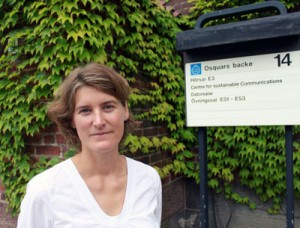Communications society’s carbon footprint mapped out
The communications industry does not just produce pixels and bytes. All in all, the IT and telecom sectors along with the media sector account for 3 percent of total global carbon emissions. This is the result of the first comprehensive academic study of the communications industry’s global climate impact.


The figures were presented by a research team at the Centre for Sustainable Communications where representatives from KTH, Ericsson and TeliaSonera form a part.
According to the study, the IT and telecom sector in 2007 accounted for 1.3 percent of the world’s total greenhouse emissions, equivalent to 620 megatons of carbon dioxide equivalent (CO2e). The media and entertainment sector accounted for 1.7 percent of world greenhouse emissions, or 820 megatons of CO2e. In total, the communications industry gives rise to 3 percent of total global greenhouse emissions i.e. 1440 megatons of CO2e.
The team behind the study adopted a comprehensive approach to the entire communications industry, which includes data, mobile and fixed telephony, television, print media and other media products (music players, digital cameras, game consoles, etc.). The figures also include the actual IT infrastructure (networks and data centres) that are necessary to enable the global services.
An interesting result is that the production of communications technology accounts for a relatively large share of total emissions, but operations still account for about twice as much in total. A clear example is television use which produces three times as much climate emissions as the manufacture of television sets and other television-related products.
“There is great potential to reduce energy consumption for consumer and network products. A future challenge for manufacturers may be to reduce the energy consumption per user to such an extent that the sector’s global energy consumption does not increase. A reduction by one half per user would mean that twice as many people may have access to communications and media for the same amount of energy spent,” says Jens Malmodin at Ericsson Research.
According to the study, there were over three billion mobile phones in use in 2007, one billion PCs and 1.7 billion TV sets. Today there are already 4.5 billion mobile phones in use.
“From a macro perspective, it is important to follow the trend for the product groups that have the greatest impact on the climate. Even if more energy efficient products are being developed, an increased variety of products will bring about adverse environmental effects all together” says Åsa Moberg, a researcher at the Centre for Sustainable Communications at KTH.
“At the same time we know that for IT communications technology, the possibility of reducing global carbon dioxide emissions is significantly greater than the emissions the sector itself generates. But this fact is no excuse for not continuing to work with energy efficiency in the sector,” adds Dag Lundén at TeliaSonera.
The study Greenhouse Gas Emissions and Operational Electricity Use in the ICT and Entertainment & Media Sector has recently been published in the Journal of Industrial Ecology.
—
The text above is a translation of the Swedish press release published October 27, 2010. For more information, contact CESC’s Communication Officer Bernhard Huber at 08-790 64 52 or bhuber@kth.se.
